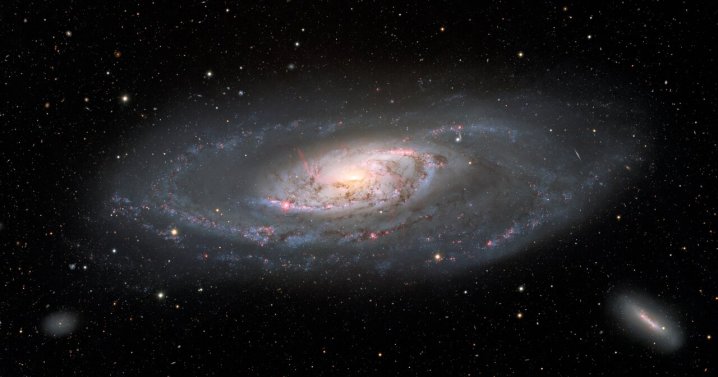
This stunning image of a distant galaxy was captured by the ground-based Nicholas U. Mayall 4-meter Telescope in the Arizona-Sonoran Desert. To capture distant objects in such detail, the telescope has a Mosaic camera that combines multiple captures into one image.
This spiral galaxy is named Messier 106, or NGC 4258, and despite its apparently tranquil appearance, it is the site of a hungry, hungry black hole. Almost all galaxies have an enormous supermassive black hole at their center, and Messier 106 is no exception.
Its supermassive black hole is 40 million times the mass of our sun, and it is particularly active. It drags in large amounts of dust and gas, chowing down on far more matter than other supermassive black holes like the one at the center of our galaxy. And the black hole in Messier 106 spins as well, rotating with such force that it actually warps the disk of gas that surrounds it.
This warping also created streamers of gas that burst from the center of the galaxy, which you can see as red lines. These appear like extra spiral arms, as most spiral galaxies have just one pair of arms which consist of groups of stars. The red “arms” in Messier 106 are made up of gas rather than stars, but they add to the unusual features of this active galaxy.
This galaxy is very large, at more than 130,000 light-years across. It is similar in terms of both size and brightness to our neighboring galaxy, the Andromeda galaxy, which is visible with the naked eye. But because Messier 106 is 10 times more distant than Andromeda, it appears very small in the night sky. However, it can be spotted using a telescope, which makes it a favorite target for amateur astronomers.
Messier 106 is also of interest to cosmologists, as it is used in measuring the size of the universe as part of a measurement called the cosmic distance ladder.
Editors' Recommendations
- Biggest stellar black hole to date discovered in our galaxy
- Record-breaking supermassive black hole is oldest even seen in X-rays
- James Webb spots the most distant active supermassive black hole ever discovered
- Supermassive black hole spews out jet of matter in first-of-its-kind image
- James Webb captures a stunning image of two galaxies merging




